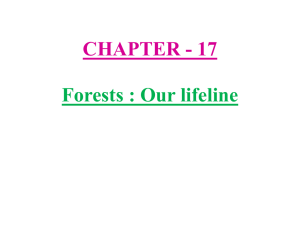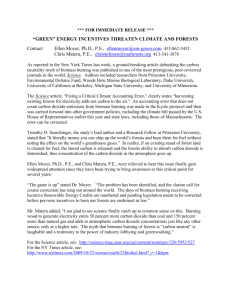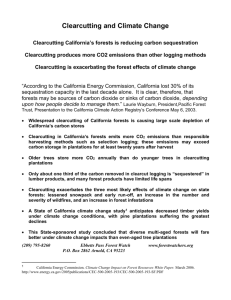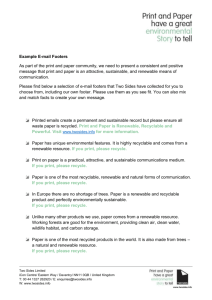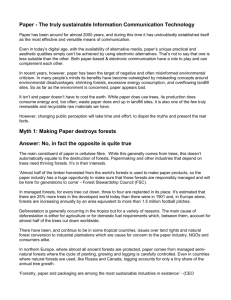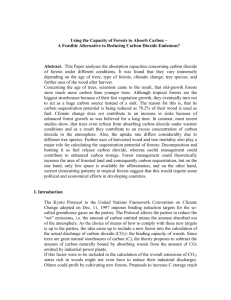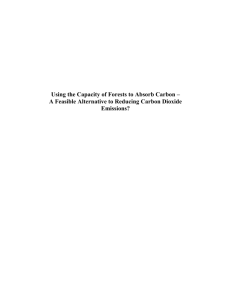Suggested Topics for Misconceptions and Confusions Assumption
advertisement
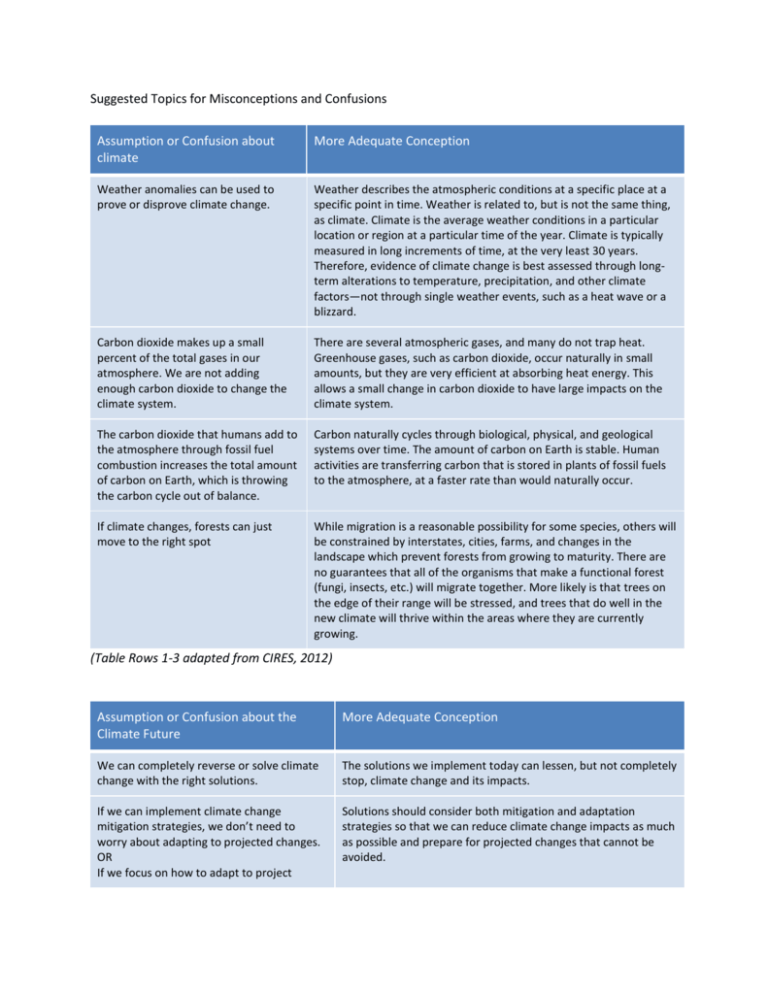
Suggested Topics for Misconceptions and Confusions Assumption or Confusion about climate More Adequate Conception Weather anomalies can be used to prove or disprove climate change. Weather describes the atmospheric conditions at a specific place at a specific point in time. Weather is related to, but is not the same thing, as climate. Climate is the average weather conditions in a particular location or region at a particular time of the year. Climate is typically measured in long increments of time, at the very least 30 years. Therefore, evidence of climate change is best assessed through longterm alterations to temperature, precipitation, and other climate factors—not through single weather events, such as a heat wave or a blizzard. Carbon dioxide makes up a small percent of the total gases in our atmosphere. We are not adding enough carbon dioxide to change the climate system. There are several atmospheric gases, and many do not trap heat. Greenhouse gases, such as carbon dioxide, occur naturally in small amounts, but they are very efficient at absorbing heat energy. This allows a small change in carbon dioxide to have large impacts on the climate system. The carbon dioxide that humans add to the atmosphere through fossil fuel combustion increases the total amount of carbon on Earth, which is throwing the carbon cycle out of balance. Carbon naturally cycles through biological, physical, and geological systems over time. The amount of carbon on Earth is stable. Human activities are transferring carbon that is stored in plants of fossil fuels to the atmosphere, at a faster rate than would naturally occur. If climate changes, forests can just move to the right spot While migration is a reasonable possibility for some species, others will be constrained by interstates, cities, farms, and changes in the landscape which prevent forests from growing to maturity. There are no guarantees that all of the organisms that make a functional forest (fungi, insects, etc.) will migrate together. More likely is that trees on the edge of their range will be stressed, and trees that do well in the new climate will thrive within the areas where they are currently growing. (Table Rows 1-3 adapted from CIRES, 2012) Assumption or Confusion about the Climate Future More Adequate Conception We can completely reverse or solve climate change with the right solutions. The solutions we implement today can lessen, but not completely stop, climate change and its impacts. If we can implement climate change mitigation strategies, we don’t need to worry about adapting to projected changes. OR If we focus on how to adapt to project Solutions should consider both mitigation and adaptation strategies so that we can reduce climate change impacts as much as possible and prepare for projected changes that cannot be avoided. climate changes, we don’t need to change our behaviors using mitigation strategies. Assumption or Confusion about Forest Management More Adequate Conception Nature knows best. Leaving forests alone is the best way for them to grow. There are many advantages to wild, natural forests. People’s enjoyment of and interaction with these forests may affect them, however, whether we intend to or not. Some people believe we have an obligation to counterbalance the effects we create by careful management. In addition, If landowners wish to maximize certain components of their forest, such as recreational trails or timber, the forest can better meet those objectives with management. Dead trees next to parking lots could be removed for safety. Seedlings with superior genes can be planted. In the face of climate change, natural evolution may not be able to accommodate the potential changes. Foresters know best. Trained professionals can determine how to make any property profitable. Professional foresters and researchers have many solutions to increasing the growth of trees and making forests more profitable and improving the forest for other objectives, too. In some areas, such as where soil nutrients are depleted, management may help, but still not overcome severe problems. As climate varies, however, changes such as insect pests, exotic diseases, hurricanes, drought, and flood will make it challenging for the best foresters to predict the best management plan. Helping the forest resist problems and flourish despite the changes may be the best solution. Forests are here for everyone. The forested landscape provides many ecosystem services that everyone benefits from, such as improved air quality, groundwater recharge, and biodiversity. Many forests in the Southeast are privately owned, however, and those landowners determine how to manage their forest. They may want a patch of wild nature for their family or steady income from harvesting timber. The United States does not have a legal mechanism for managing private property unless the landowners have entered their property in a land trust or conservation easement. Genetically modified organisms are evil. Farmers have been selecting the best plants and domestic animals for breeding for thousands of years. Forest and horticultural geneticists also use traditional plant breeding methods to select traits, fertilize cones with selected pollen, and save the seedlings with the best form, fastest growth, and resistance to insects and disease. All of the crops that provide food for millions of people and many of the trees planted in urban areas have been grown from selected varieties and seeds. A plant with genes inserted from another species is known as a genetically modified organism (GMO) and is very strictly regulated and tested before release to the general public. Examples of GMO plants include Round-up® ready soybeans and Bt-insect resistant corn that makes up almost all of the commercial production for those crops in the USA. GMO methodology has not yet been applied to commercially available native pines. It can be applied very quickly and may be the only practical way to introduce resistance to introduced diseases for which the host has no natural tolerance. Assumption or Confusion about Carbon More Adequate Conception Plants either do not respire, or if they do, they only respire in the dark (Haslam and Treagust, 1987). Plants constantly break down sugar molecules— even to provide the energy needed for photosynthesis. Oxygen is needed for animals, whereas carbon dioxide is needed by plants (Anderson et al., 1990). Oxygen in the form of water is critical to plant life. Gases are not matter or they don’t have mass (Benson et al., 1993). Anything that has matter has mass. Frozen, compressed carbon dioxide is dry ice and has mass. A gas has mass, too, just a lot less. Food that is broken down in respiration leaves an animal’s body entirely by urine and feces (Wilson et al., 2006) The carbon may also leave an animal through sweat and exhalation. Respiration produces energy, rather than converts energy (Gayford, 1986). Respiration converts energy from one form to another. Energy is used up during biological processes (Wilson et al., 2006). Energy cycles. “Used” energy becomes waste heat. Gases such as carbon dioxide lack sufficient mass to lead to the development of dry biomass in plants. Plants get mass from the soil (Driver et al., 1994) By removing carbon from carbon dioxide and gluing carbon atoms together, plants create biomass from a gas and water. (Table adapted from Hartley, Wilke, Schramm, D’Avanzo, & Anderson, 2011) Assumption or Confusion about Life Cycle Assessment More Adequate Conception Recycled is another word for renewable resources. Recycled means that the product was returned to a pre-production state and used to make new products. Glass is melted down and paper is re-pulped. Renewable means the original ingredients of the product are from capable of reproducing or reforming, such as deer, trees, and soil. Resources that are not renewable are in limited supply, such as minerals. Plastic bottles made from petroleum are recyclable but not from a renewable resource. Life cycle assessment is easy to do on any product. The more ingredients a product has, the more difficult it is to determine the impact of every ingredient. Everyday products, like a cell phone, are comprised of dozens of different materials and parts, which can each have a separate path of production. Some production processes are proprietary information and not available to curious consumers. While everything has some level of environmental impact, it is often difficult to know what it is. The way a product is produced represents the largest impacts of a product’s life cycle. The materials and energy needed to make a product may represent larger impacts than other stages of the life cycle, but this is not always the case. For example, with cotton clothing, the amount of energy consumed to wash the article with hot water and to dry the article can be more than the energy used during production. Life cycle assessment can tell us which product is better. Determining ‘better’ is often difficult because there is not a direct comparison between impacts (even if they are all quantifiable). Which is worse, water pollution or climate change? Using a nonrenewable feedstock for a product that lasts 50 years, or using a disposable and renewable material? Such questions are the essence of interesting debate and often decided with values, not science. All products are made the same way. People can tell the difference between different brands of ice cream because they have different ingredients and may be made in a different manner. The same may be true for various brands of anything. This makes life cycle analysis difficult, since brands may be produced differently.

